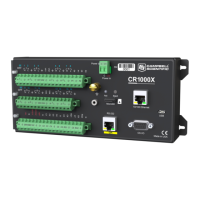l Using MeasOff = True for better offset compensation.
l Using excitation reversal (RevEx = True) with bridge measurements.
l Programming longer settling times.
Single-ended measurements are susceptible to voltage drop at the ground terminal caused by
return currents from another device that is powered from the datalogger wiring panel, such as
another manufacturer's communications modem, or a sensor that requires a lot of power.
Currents greater than 5 mA are usually undesirable. The error can be avoided by routing power
grounds from these other devices to a power ground G terminal, rather than using a signal
ground ( ) terminal. Ground currents can be caused by the excitation of resistive-bridge
sensors, but these do not usually cause offset error. These currents typically only flow when a
voltage excitation is applied. Return currents associated with voltage excitation cannot influence
other single-ended measurements because the excitation is usually turned off before the
datalogger moves to the next measurement. However, if the CRBasic program is written in such a
way that an excitation terminal is enabled during an unrelated measurement of a small voltage,
an offset error may occur.
The Seebeck effect results in small thermally induced voltages across junctions of dissimilar
metals as are common in electronic devices. Differential measurements are more immune to
these than are single-ended measurements because of passive voltage cancellation occurring
between matched high and low pairs such as 1H/1L. So, use differential measurements when
measuring critical low-level voltages, especially those below 200 mV, such as are output from
pyranometers and thermocouples.
When analogue voltage signals are measured in series by a single measurement instruction, such
as occurs when VoltSE() is programmed with Reps = 2 or more, measurements on
subsequent terminals may be affected by an offset, the magnitude of which is a function of the
voltage from the previous measurement. While this offset is usually small and negligible when
measuring large signals, significant error, or NAN, can occur when measuring very small signals.
This effect is caused by dielectric absorption of the integrator capacitor and cannot be overcome
by circuit design. Remedies include the following:
l Programing longer settling times.
l Using an individual instruction for each input terminal, the effect of which is to reset the
integrator circuit prior to filtering.
l Avoiding preceding a very small voltage input with a very large voltage input in a
measurement sequence if a single measurement instruction must be used.
6. Measurements 58

